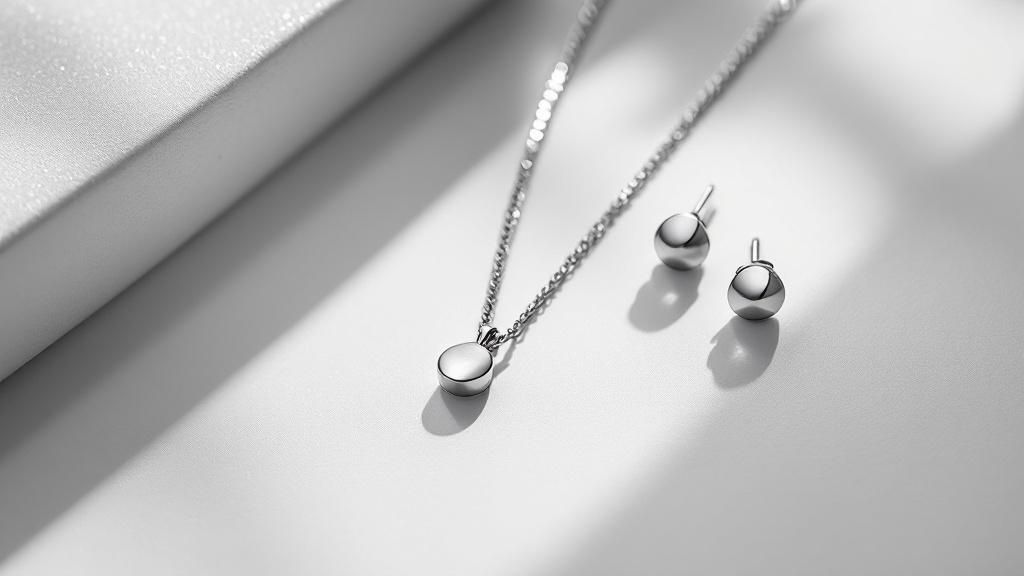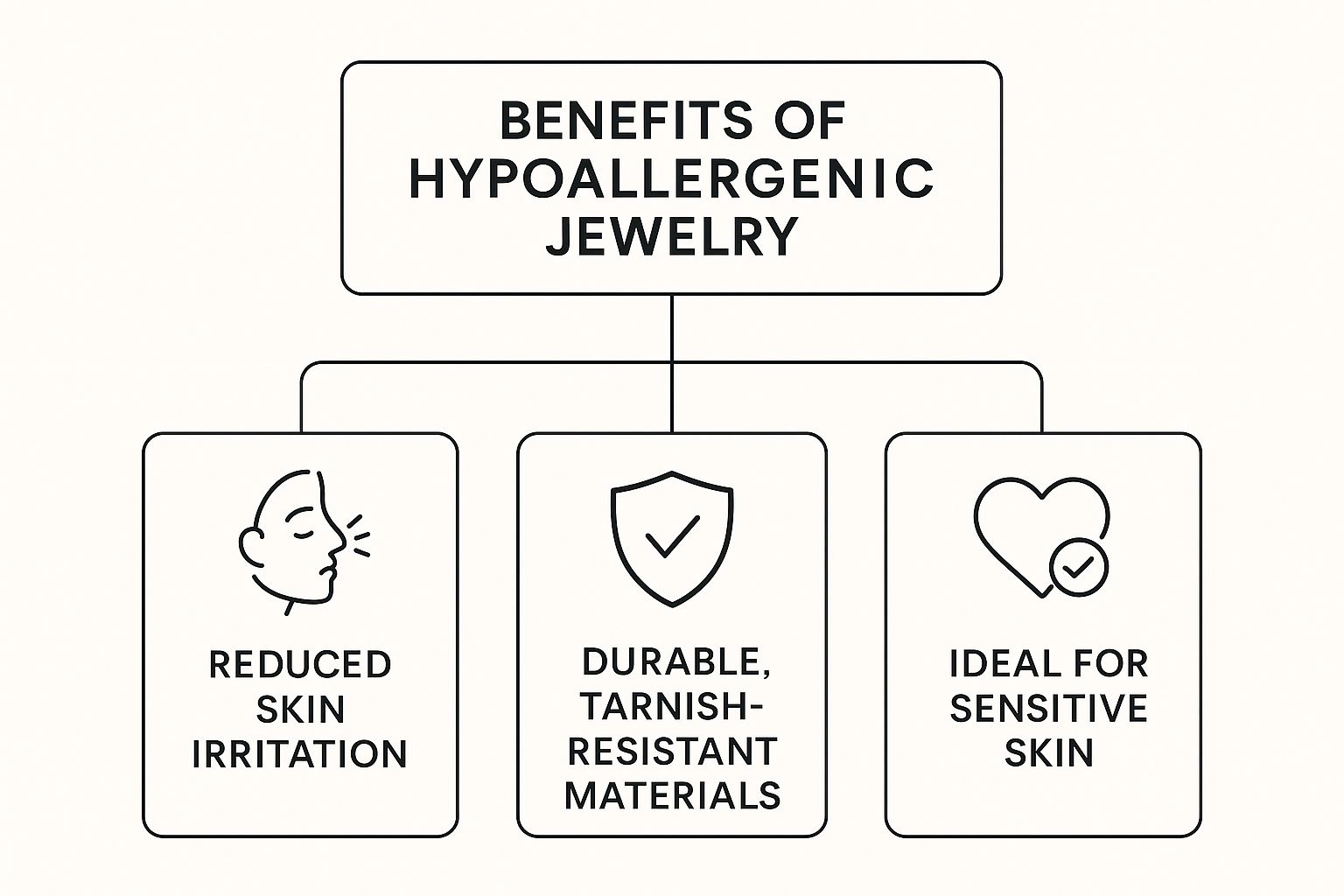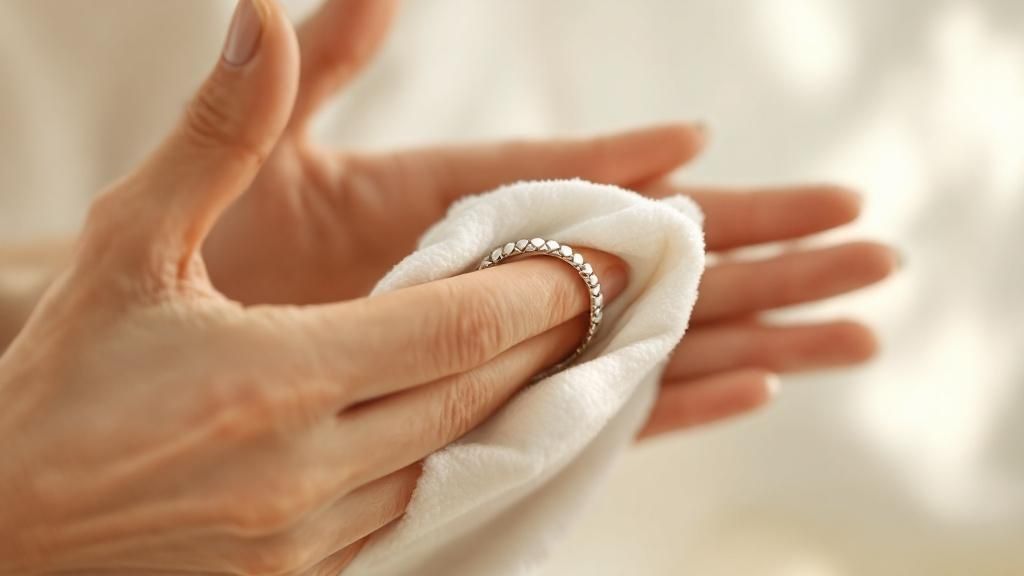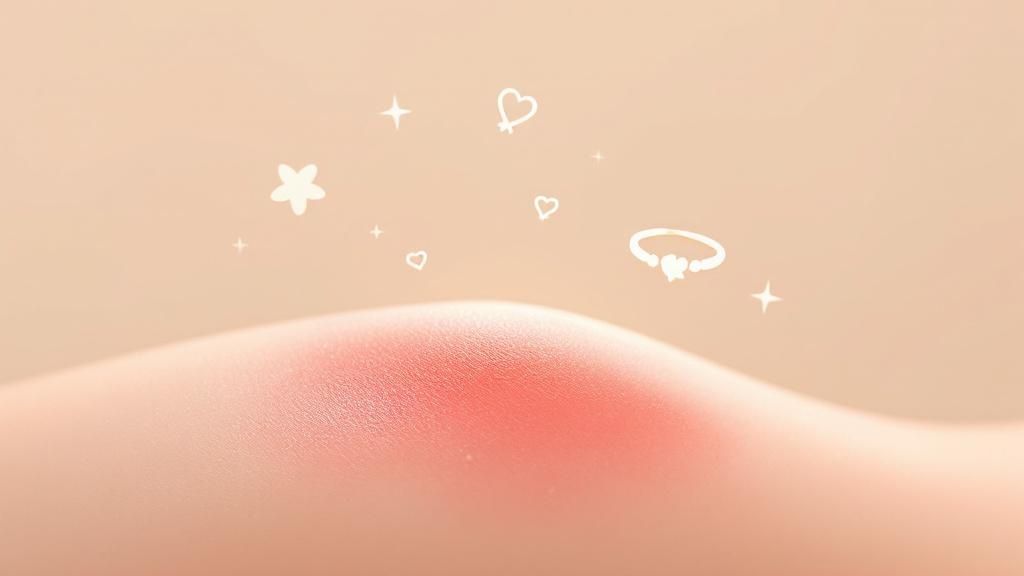Discover Trusted Hypoallergenic Jewelry for Sensitive Skin
- Luke Zucco
- Jul 22
- 14 min read
If you've ever experienced that tell-tale itchy, red rash after wearing a new pair of earrings or a necklace, you've likely asked yourself: what is hypoallergenic jewelry, really?
The simplest answer is that it’s jewelry made from materials that are far less likely to cause an allergic reaction. It's not an ironclad guarantee against irritation, but it's a significant step toward comfort, especially for those of us with sensitive skin.
What Does Hypoallergenic Jewelry Actually Mean?

The term "hypoallergenic" can feel a bit vague, and that's because it isn't a strictly regulated or standardized claim in the jewelry world. Think of it like the "low-fat" label on food—it means there's less of something, not a total absence of it. For jewelry, that "something" is almost always nickel.
Nickel is a common metal used in alloys to make jewelry stronger and more affordable. The problem? It’s the number one cause of contact dermatitis, that frustrating rash that pops up when your skin touches an irritant. Hypoallergenic jewelry is crafted specifically to minimize or, ideally, eliminate nickel altogether.
Key Takeaway: The whole point of hypoallergenic jewelry is to use purer, more biocompatible metals. This prevents your body’s immune system from going on the defensive and reacting to your accessories.
This shift toward skin-safe materials is more than just a trend. The global jewelry market, currently valued at around $232.94 billion, is expected to grow to $343.90 billion by 2032. Hypoallergenic pieces are a fast-growing part of this massive industry, fueled by people who want both beauty and well-being from their jewelry. This niche focuses on materials like surgical-grade stainless steel, titanium, and high-karat golds. You can discover more insights about this growing market and the consumer demands driving it.
Common Jewelry Allergens vs Safe Alternatives
To make things clearer, it helps to see the common culprits side-by-side with their safer counterparts. This table gives you a quick reference for what to avoid and what to look for.
Common Allergen | Potential Skin Reaction | Recommended Hypoallergenic Alternative |
|---|---|---|
Nickel | The most frequent cause of red, itchy rashes and blisters. | Titanium, Surgical-Grade Stainless Steel |
Lead | Can cause serious skin irritation and has other health risks. | Platinum, Niobium |
Brass/Copper | May cause a greenish skin discoloration and mild irritation. | 14k+ Gold, Sterling Silver |
Cobalt | Often found in alloys; can trigger dermatitis similar to nickel. | Palladium, Tungsten Carbide |
Ultimately, choosing safe jewelry comes down to knowing which metals are your friends and which are your foes.
Debunking Common Myths
To truly understand what you're buying, we need to bust a few myths that float around.
Myth: If it’s expensive, it must be hypoallergenic.
Reality: Price is no guarantee. Some pricey white gold pieces, for example, are mixed with nickel to get that silvery sheen, making them a potential irritant despite their cost.
Myth: All "real" gold is safe for sensitive skin.
Reality: Purity is what counts. Gold that's less than 14 karats contains a higher percentage of other metals, and one of them is often nickel. An 18k gold ring will almost always be a safer bet than a 10k one.
In the end, choosing hypoallergenic jewelry is all about becoming a savvy consumer. It means looking past the brand name or the price tag and focusing on what the piece is actually made of. That knowledge is what empowers you to pick beautiful accessories you can wear with confidence, day in and day out, without ever worrying about that dreaded itch.
Discovering the Safest Metals for Sensitive Skin
Alright, now that we’ve covered the common culprits behind skin irritation, let's get to the good stuff—the metals you can actually wear without a second thought. Finding beautiful jewelry shouldn't feel like a risky gamble. Think of this as your personal guide to the most reliable and skin-friendly materials out there.
This quick visual breaks down why making the switch to hypoallergenic jewelry is such a game-changer.

As you can see, it’s not just about dodging a nasty rash. It's about investing in high-quality, durable pieces that are genuinely kind to your skin.
The Medical-Grade Champions
When it comes to pure, unadulterated safety, a few metals are simply in a class of their own. These materials are so incredibly non-reactive that they’re trusted for medical implants—the kind that go inside the human body. You can't get a better seal of approval than that.
Titanium is the undisputed king for anyone with sensitive skin. It's 100% nickel-free, incredibly strong, and so lightweight you might forget you're even wearing it. The fact that surgeons use it for hip replacements and bone screws tells you everything you need to know about its safety.
Niobium is another fantastic choice, and it's a favorite among professional piercers, especially for fresh piercings. Just like titanium, it's a pure element with no nickel or other common irritants. It's also fantastically resistant to corrosion, so it won’t tarnish, degrade, or react with your skin over time.
Reliable and Accessible Options
Beyond the medical-grade powerhouses, there are several other excellent materials that strike a perfect balance between safety, style, and cost. These are your go-to options for building a versatile, everyday jewelry collection that won't betray your skin.
Surgical-Grade Stainless Steel: This is one of the most common and affordable hypoallergenic metals you'll find. While it technically contains a tiny bit of nickel, the alloy is structured in a way that the nickel is tightly locked in, making it extremely unlikely to leach out and cause a reaction.
Platinum: If you're looking for luxury, platinum is it. This premium metal is naturally hypoallergenic and intensely durable. Its stunning silvery-white sheen never fades or tarnishes, making it a fantastic investment for milestone pieces like wedding rings.
Expert Tip: A new piercing is essentially an open wound that your body is trying to heal. During this delicate phase, it's absolutely critical to stick with the highest-purity materials like implant-grade titanium or niobium. This helps prevent irritation and ensures the healing process goes as smoothly as possible.
Understanding Gold Karats
Gold is a timeless classic, but its friendliness to sensitive skin depends entirely on its purity, which is measured in karats. Pure, 24k gold is actually too soft for most jewelry, so it's mixed with other metals (alloys) to make it stronger.
For sensitive skin, a good rule of thumb is to stick with 14k gold or higher.
14k Gold: This alloy is 58.3% pure gold. It hits the sweet spot between durability and purity, making it a safe choice for most people.
18k Gold: At 75% pure gold, this option significantly reduces the percentage of other metals in the mix. It's an excellent and often safer choice for those with extreme sensitivities.
Lower-karat golds, like 10k, have a higher concentration of alloy metals, which increases the odds that nickel is one of them.
To help you sort through all these options, I've put together a quick comparison chart.
Hypoallergenic Metals At-a-Glance
This table gives you a side-by-side look at the top hypoallergenic metals, highlighting what makes each one unique. Use it to quickly decide which material best fits your needs, budget, and lifestyle.
Metal | Hypoallergenic Rating | Durability | Typical Cost | Best For |
|---|---|---|---|---|
Titanium | Excellent | Very High | Low to Mid | New piercings, daily wear, extreme allergies |
Niobium | Excellent | High | Low to Mid | Fresh piercings, colorful anodized options |
Platinum | Excellent | Very High | Very High | Wedding bands, fine jewelry, investment pieces |
18k+ Gold | Very Good | Good | High | Fine jewelry for highly sensitive skin |
Surgical Stainless Steel | Good | Very High | Low | Everyday jewelry, budget-conscious buyers |
Ultimately, the best metal is the one that feels great on your skin and fits your personal style. For a more in-depth look, feel free to check out our complete guide on the top hypoallergenic jewelry metals for sensitive skin to find your perfect match.
Why Sustainable Jewelry Is Often Safer Jewelry

It might seem surprising, but choosing jewelry that’s kind to your skin often leads you to pieces that are also kinder to the planet. This isn't just a happy coincidence. The worlds of sustainable and hypoallergenic jewelry overlap in some really important ways, giving us options that are better for our bodies and the environment.
At the heart of sustainable jewelry is a commitment to responsible practices. Think recycled metals, ethically sourced gemstones, and manufacturing methods designed to leave a smaller footprint. One of the biggest upsides of this approach is the purity of the materials. For example, when a brand uses recycled gold or platinum, they don't just melt it down; they refine it back to its pure form before mixing new alloys.
This purification step is fantastic news for anyone with sensitive skin. It strips out unknown contaminants and trace metals that might have been lurking in the original source material. The result? A final product that's far less likely to harbor hidden irritants, making jewelry from recycled metals a naturally safer bet.
The Purity of Lab-Grown and Recycled Materials
The push for sustainable materials isn't just an ethical trend—it's a massive market force. Today’s shoppers want to know where their products come from, and that demand for transparency is pushing brands to clean up their acts. This has sparked a huge boom in the sustainable jewelry market, which was valued at $58.5 billion in 2023 and is expected to rocket to $97.8 billion by 2032. This incredible growth is directly linked to the rising demand for eco-friendly and ethically made jewelry, which, thanks to its controlled production, often happens to be hypoallergenic. You can read the full research about this market trend to see just how much consumer values are reshaping the industry.
We see this same shift in the rise of lab-grown gemstones. Created in meticulously controlled environments, these gems are physically and chemically identical to their mined counterparts but sidestep the environmental and ethical baggage. Crucially for our skin, they also don't come with the risk of being set in cheap, nickel-heavy alloys that are common in mass-produced jewelry.
Key Insight: Sustainable practices often lead to purer materials. Whether we're talking about recycled metals being refined to a pristine state or lab-grown gems created in a sterile setting, the end product is cleaner. By extension, it’s a much more reliable form of hypoallergenic jewelry.
How to Spot Genuinely Sustainable Brands
Of course, with any positive trend comes the risk of "greenwashing"—when companies make fuzzy or misleading claims about their environmental cred. To make a choice that's truly safe for you and the planet, you need to know what to look for.
Here are a few tell-tale signs of a genuinely sustainable brand:
Material Transparency: They’re upfront about where their metals and stones come from. Look for specific callouts like "100% recycled 14k gold" or "conflict-free lab-grown diamonds."
Detailed Sourcing Information: Good brands are proud of their supply chain. They won't just use vague labels; they'll often share details about the origin of their materials.
Third-Party Certifications: Keep an eye out for official seals of approval from organizations that independently verify ethical and environmental standards.
By keeping these points in mind, you can feel confident that your beautiful new piece is not only safe for your skin but also aligns with your values. For those ready to dive deeper, you can discover stylish eco-friendly jewelry today and learn how to make choices that look good and do good.
Of course. Here is the rewritten section, focusing on a natural, expert-written tone while meeting all your requirements.
How New Generations Are Redefining Fine Jewelry
The fine jewelry world is in the middle of a major shake-up, and it’s being led by a completely new kind of buyer. It’s not just about the four C’s or the biggest diamond anymore. For Millennials and Gen Z, the story behind a piece of jewelry matters just as much as its sparkle. This shift is turning hypoallergenic jewelry from a small, specialized market into a major player.
For these younger buyers, jewelry isn't just an accessory; it's a statement about who they are and what they believe in. They’re looking for authenticity, wellness, and ethical practices, often choosing them over big-name brands or flashy trends. They’re asking the hard questions: Where did the gold come from? What other metals are in this alloy? Is this going to make my skin break out? This kind of conscious consumerism naturally leads them away from the cheap, irritating metals that used to dominate costume jewelry.
Values Driving the Demand for Safer Jewelry
This isn't just a passing fad. It’s a deep, fundamental change in what people expect from the products they buy. Younger consumers grew up with the internet, so they research everything. Armed with endless information, they're savvy enough to steer clear of jewelry loaded with common irritants like nickel, cobalt, and lead.
Their priorities are crystal clear and are reshaping the industry:
Ethical Sourcing: They want to see the receipts, figuratively speaking. Transparency is key, and they gravitate toward recycled metals and conflict-free gems.
Personal Wellness: The modern health-conscious mindset doesn't stop at diet and exercise. It extends to what they put on their bodies, making skin-safe, hypoallergenic options a must-have.
Authenticity Over Everything: They connect with brands that are real and honest about how their pieces are made and what goes into them.
This intense focus on clean, transparent products is exactly why hypoallergenic jewelry is seeing such a massive surge in popularity. It's a choice that perfectly aligns with a value system built on personal well-being and a sense of responsibility.
The bottom line is that modern consumers want to feel good about their purchases, both physically and ethically. Jewelry that causes a painful rash or is made with questionable materials simply doesn’t make the cut.
This movement is creating a huge economic shift. With their spending power on the rise, Gen Z and the emerging Gen Alpha are the ones setting the new standard. They actively seek out brands that put skin compatibility and ethical sourcing first. In fact, some experts believe any jewelry brand that fails to capture at least 10–15% of this younger demographic's spending will seriously struggle to stay relevant over the next decade. Their buying habits are a massive boost for the hypoallergenic market, as they intentionally choose safer, more transparent options. If you want to dive deeper into this powerful shift, you can explore more insights about these jewelry consumer trends.
Your Checklist for Buying and Caring for Jewelry

Now that you know what hypoallergenic jewelry is all about, let's put that knowledge to work. Armed with the right information, you can step into any store or browse online with total confidence. This isn't just about buying pretty things; it's about making smart investments in pieces that are safe, stylish, and made to last.
Think of yourself as a jewelry detective. Your first and most important clue is always the product description. Be wary of vague language like "metal alloy" or "fashion metal"—those are big red flags. A trustworthy seller will be proud to tell you exactly what's in their jewelry, using clear, specific terms like "implant-grade titanium," "nickel-free 14k gold," or "surgical stainless steel."
Pro Tip: If a brand is cagey about the metals they use, it's a sign to move on. Transparency isn't just good business; it’s a direct reflection of a company's commitment to your skin's safety.
If you're serious about building a collection you can rely on, our guide with 8 essential tips for buying jewelry in 2025 is a great next step.
Putting New Jewelry to the Test
Even when a label checks all the right boxes, a little real-world test is a smart move, especially for those of us with extra-sensitive skin. Before you commit to wearing those gorgeous new earrings for a full day, give them a trial run.
Just pop one in for a few hours while you're relaxing at home. Keep an eye on the spot. Are you seeing any redness, feeling any itchiness, or noticing any swelling? If your skin is calm and happy after a few hours, you can feel much more confident about wearing your new find all day long. This simple patch test can save you a world of hurt.
Caring for Your Investment
Great jewelry deserves great care. Keeping your pieces clean doesn't just maintain their sparkle; it ensures they stay safe for your skin for years to come. While different metals have slightly different needs, the golden rule is always to be gentle. Stay away from harsh chemical cleaners, abrasive polishing cloths, and most ultrasonic cleaners unless the manufacturer gives you the green light.
Here's a quick guide to keeping your favorite materials in top shape:
Titanium & Niobium: These are the superheroes of low-maintenance jewelry. A simple wash with mild soap and warm water is all they need. Pat them dry with a soft cloth, and you're done. They're built to resist tarnish and corrosion.
Surgical Stainless Steel: This workhorse metal is just as easy to clean. Soap and water will do the trick, but for an extra gleam, a gentle buff with a lint-free cloth will make it shine.
Gold (14k+) & Platinum: To keep these precious metals looking their best, give them a regular bath in a solution of warm water and a couple of drops of gentle dish soap. An old, soft-bristled toothbrush can help you carefully scrub away any grime from daily wear.
Finally, don't forget about storage. Tossing everything into one drawer is a recipe for scratches and tangles. Store each piece in a soft pouch or a fabric-lined jewelry box. This protects them from damage and reduces exposure to air and moisture, keeping them beautiful and ready to wear.
Answering Your Hypoallergenic Jewelry Questions
Even after getting the hang of safe metals, a few tricky questions always seem to pop up. We get it. That's why I've put together this quick Q&A to tackle the most common uncertainties I hear from people. Think of it as your final cheat sheet for feeling totally confident about the jewelry you buy and wear.
Let's clear the air on these last few points so you can get back to the fun part—finding pieces you absolutely love, without any of the worry.
Is Sterling Silver Considered Hypoallergenic?
This is a fantastic question because the answer isn't a simple yes or no. It really depends.
Sterling silver is an alloy, which is just a fancy way of saying it’s a mixture of metals. To be called "sterling silver," it has to contain at least 92.5% pure silver. The other 7.5% is where we need to pay attention. Pure silver is beautiful but way too soft to hold up in a ring or necklace, so other metals are added to make it stronger.
Most of the time, that other metal is copper, which doesn't bother most people. But sometimes, to save a few bucks, manufacturers will mix in nickel. And that's where the trouble begins for sensitive skin.
The only way to know for sure is to look for pieces specifically labeled “nickel-free sterling silver.” This is your guarantee that the remaining 7.5% is made of a safe metal like copper or zinc.
Want an even safer bet? Look for rhodium-plated sterling silver. Rhodium is in the same family as platinum, making it incredibly tough and one of the most hypoallergenic metals out there. The plating creates a physical barrier between your skin and the silver alloy, giving you extra protection and the added bonus of preventing tarnish.
Can I Wear Gold-Plated Jewelry with Sensitive Skin?
Honestly, standard gold-plated jewelry is usually a gamble if your skin is reactive. The problem isn’t the thin layer of gold on the surface; it’s what’s hiding underneath.
Gold plating is a process where a whisper-thin layer of gold is applied over a base metal. More often than not, that base is brass or another cheap alloy that’s loaded with nickel. While that gold layer acts as a shield at first, it's not meant to last. Friction, sweat, and just daily life will eventually wear it away. Once it's gone, your skin is in direct contact with the nickel-heavy base, and that’s a perfect recipe for an itchy, red reaction.
If you love the look of gold but need something kinder to your skin, you have much better options:
Gold Vermeil: This is a huge step up. Gold vermeil (pronounced 'ver-may') has a much thicker coating of gold—at least 2.5 microns—and it's always layered over a sterling silver base. Since the metal underneath is nickel-free, it’s a far safer choice.
Solid Gold (14k or higher): For jewelry you'll wear every day, investing in solid 14k or 18k gold is the most reliable path to comfort. There’s no plating that can wear off, so you get consistent, worry-free wear for years to come.
What Should I Do If I Have an Allergic Reaction?
First things first: don't try to power through it. The second you feel that tell-tale itch or see redness starting, take the piece of jewelry off. This is the single most important step to keep the reaction from getting worse.
Next, gently wash the affected skin with a mild, fragrance-free soap and warm water. Carefully pat the area completely dry with a soft towel—rubbing will only irritate it more. For mild symptoms like itching and redness, an over-the-counter hydrocortisone cream can work wonders to calm things down.
Most importantly, don't wear that piece of jewelry again. Your body has now flagged it as an irritant, and any future exposure will likely cause a faster, more intense reaction. If the rash is severe, shows signs of infection (like pus or increasing pain), or doesn't start improving in a day or two, it’s time to call a doctor or dermatologist.
At Panther De Luxe Shop, we believe everyone deserves to wear beautiful jewelry with total confidence and comfort. Our collections are built around high-quality, skin-safe materials, so you never have to choose between your style and your well-being. Come explore our stunning, worry-free pieces today.

Comments